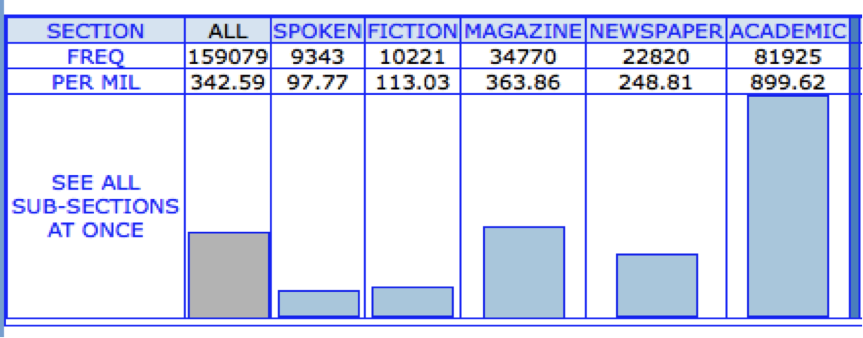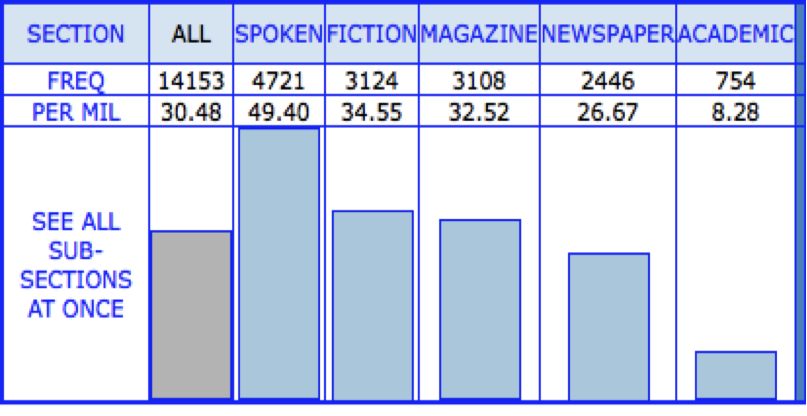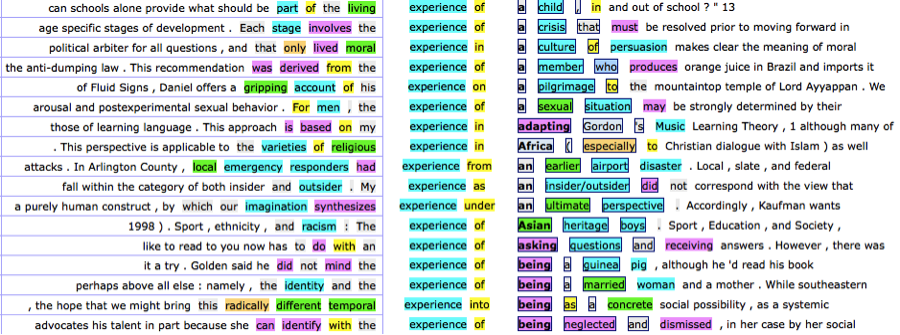Contents
Content Type: 3
Title: Corpus-Aided Pedagogy for Language Classrooms
Body:
Robert Poole is a PhD candidate in Second Language Acquisition and Teaching at the University of Arizona. His primary interests are technology and corpora in the classroom, L2 writing, and corpus-based discourse analysis. In addition to his experience teaching freshman writing and ESL in the U.S, he has taught in Guyana, Nicaragua, and South Korea. Follow Robert on Twitter @RobertEPoole.
A corpus (pl. corpora) is a large, searchable collection of naturally occurring language that can be used by researchers, teachers, and students for a variety of purposes. Some well-known corpora are the Corpus of Contemporary American English (COCA), the British National Corpus (BNC), the Corpus del Español, and the Corpus do Português. These are large corpora that contain millions of words collected from textbooks, magazines, newspapers, television shows, etc. There are also specialized corpora such as the Michigan Corpus of Undergraduate Student Papers (MICUSP), the Time Magazine Corpus, and the Indianapolis Business Learner Corpus (IBLC) which are designed to represent a particular genre or target discourse. These corpora and others make it possible for language instructors to test hypotheses and answer questions about language use and provide authentic samples of language from a variety of contexts.
In recent years, corpus findings are also influencing language learning materials (e.g. Conrad & Biber’s Real grammar: A corpus-based approach to English and Blass, Iannuzi, Savage, & Reppen’s Grammar and Beyond series) and are increasingly informing classroom pedagogy for vocabulary learning (Chambers, 2005 & 2007; Cobb, 1997 & 1999; Varley, 2009), grammar instruction (Liu and Jiang, 2009), and writing development (Friginal, 2013). These applications of corpora to language learning classrooms have been aided by the creation of corpora in many different languages and tremendous growth in user-friendly websites such as wordandphrase.info and SkELL (Sketch Engine for language learning) that provide rich learning spaces for students to explore language. In addition, students and teachers can now create their own corpora (e.g. a small corpus of student essays, letters of application, or articles from a campus newspaper) with the help of corpus tools such as Antconc (Anthony, 2014; see Charles, 2012 & 2013 for D.I.Y. corpus in the classroom). Corpus-aided pedagogy will continue to expand into language classrooms as more online corpora are developed and more instructors understand the value a corpus approach can offer.
The following are a few ways corpus activities may be integrated into the classroom.
1. Comparing the use of a particular word or words between two registers or genres: For example, a writing teacher could display corpus data on how linking adverbials are used in a particular target discourse (e.g. Friginal, 2013) or how conjunctions are rarely used to begin sentences in academic writing.
Image 1: Corpus data for the use of however

2. Using a corpora for revision and word choice activities: Corpora can be a valuable resource to students searching for the proper preposition to use or for deciding whether to use a phrasal verb or its one-word synonym. For example, a quick search in the Corpus of Contemporary American English (COCA) will show that phrasal verbs, e.g. figure out, is much less common in academic writing than discover. See Liu and Jiang (2009) for how to use corpora for revision activities.
Image 2: figure out in the COCA

Image 3: discover in the COCA

3. Determining semantic field: This type of activity asks students to compare the collocations between near synonyms. For example, students could compare the collocations of major, chief, and primary to determine the contexts where these words are most often used.
Image 4: semantic fields of near-synonyms beautiful and attractive

4. Exploring grammar: Many corpora such as the COCA provide concordance lines with each word color-coded for part of speech. Searching for a word of interest and examining the color-coded results can help students notice syntactic patterns in which a word frequently occurs.
Image 5: KWIC lines for experience

Additional Readings
Bennett, G. (2010). Using corpora in the language learning classroom: Corpus linguistics for teachers. Ann Arbor: University of Michigan Press.
Reppen, R. (2010). Using corpora in the language classroom. New York: Cambridge University Press.
References
Anthony, L. 2014. AntConc 3.4.3 [Computer Software]. Tokyo, Japan: Waseda University. Available from http://www.laurenceanthony.net/
Blass, L., Iannuzi, S., Savage, A., & Reppen, R. (2012). Grammar and beyond. Cambridge: Cambridge University Press.
Chambers, A. (2005). Integrating corpus consultation in language studies. Language Learning and Technology, 9 (2), 111-125.
Charles, M. (2012). Proper vocabulary and juicy collocations: EAP students evaluate do-it-yourself corpus-building. English for Specific Purposes, 31, 93–102.
Charles, M. (2013). Getting the corpus habit: EAP students long term use of personal corpora. English for Specific Purposes, 35, 30-40.
Cobb, T. (1997). Is there any measurable learning from hands-on concordancing?. System, 25(3), 301-315.
Cobb, T. (1999). Breadth and depth of lexical acquisition with hands-on concordancing. Computer Assisted Language Learning, 12(4), 345-360.
Conrad, S., & Biber, D. (2009). Real grammar: A corpus-based approach to English. New York: Pearson ESL.
Friginal, E. (2013). Developing research report skills using corpora. English for Specific Purposes, 32, 208-220.
Liu, D. & Jiang, P. (2009). Using a corpus-based lexicogrammatical approach to grammar instruction in EFL and ESL contexts. The Modern Language Journal, 93(1), 61-78.
Varley, S. (2009). I’ll just look that up in the concordance: integrating corpus consultation into the language learning environment. Computer Assisted Language Learning, 22(2), 133-152.
Source: CASLS Topic of the Week
Inputdate: 2015-01-22 19:47:09
Lastmodifieddate: 2015-02-02 03:11:59
Expdate:
Publishdate: 2015-02-02 02:15:01
Displaydate: 2015-02-02 00:00:00
Active: 1
Emailed: 1
Isarchived: 0
Content Type: 4
Title: Corpus Activities for L2 Writing
Body:
by Robert Poole
Description: These are basic corpus searches using the Corpus of Contemporary American English (COCA) at corpus.byu.edu designed to be completed by students for homework to explore language beyond the classroom. As an EAP writing teacher, I feel asking students to become language researchers, study authentic language samples, and formulate their own usage guidelines is more productive than margin comments and explanations.
Procedures: Hand out one question at the closing of class to be completed for homework. Ask students to record their findings and briefly report the implications for their writing practices.
These prompts were created in response to common errors I encounter in my undergraduate L2 writing course. These prompts can be modified for various proficiency levels. Teachers can craft their own corpus activities based on the errors observed in their students’ output.
Download the handout with the four activities here.
If you and your students are new to using the COCA, here is a handout explaining how to use it.
Source: CASLS Activity of the Week
Inputdate: 2015-01-22 20:02:23
Lastmodifieddate: 2015-02-02 03:11:59
Expdate:
Publishdate: 2015-02-02 02:15:01
Displaydate: 2015-02-02 00:00:00
Active: 1
Emailed: 1
Isarchived: 0
Content Type: 2
Title: Call for Presentations: COFLT Spring Conference
Body:
The 2015 COFLT Spring Conference is just around the corner. We are now accepting proposals for both workshops and presentations.
COFLT 2015 Spring Conference
Willamette University, Salem, OR
March 7, 2015
Presentation Requirements
Theme:
Presentations or workshops should clearly support the theme of the Spring Conference: Inspire. Engage. Transform. Proposals are welcome from individuals or small groups.
Content Focus:
Presentations or workshops will address one of the following focus areas
• Pedagogy & Practice
• Advocacy & Service
• Scholarship & Research
Deadlines and Selection Process:
Proposals are accepted through Monday, February 10, 2015. Proposals will be reviewed on a rolling basis. Final notification of selection is February 14, 2015. Selected presenters will receive a conference registration discount for themselves or a colleague.
Membership:
You are not required to be a COFLT member to submit a proposal; however, you are required to be a member in good standing to present at the conference.
Submissions:
To complete the submission form, have the following information available:
• Name, school, and teaching language of all presenters.
• Title and 500 word abstract written in the 3rd person
• 300 word biography written in the 3rd person
• Target audience
If you have any questions, contact us at COFLToregon@gmail.com.
Source: COFLT
Inputdate: 2015-01-23 05:50:36
Lastmodifieddate: 2015-01-26 07:39:59
Expdate: 2015-03-07 00:00:00
Publishdate: 2015-01-26 02:15:01
Displaydate: 2015-01-26 00:00:00
Active: 1
Emailed: 1
Isarchived: 0
Content Type: 1
Title: Book: Family Language Learning: Learn Another Language, Raise Bilingual Children
Body:
From http://www.multilingual-matters.com/display.asp?isb=9781783092796
Family Language Learning: Learn Another Language, Raise Bilingual Children
By Christine Jernigan
Published by Multilingual Matters
Family Language Learning is a practical guide designed to support, advise and encourage any parents who are hoping to raise their children bilingually. It is unique in that it focuses on parents who are not native speakers of a foreign language. It gives parents the tools they need to cultivate and nurture their own language skills while giving their children an opportunity to learn another language. The book combines cutting-edge research on language exposure with honest and often humorous stories from personal interviews with families speaking a foreign language at home. By dispelling long-held myths about how language is learned, it provides hope to parents who want to give their children bilingual childhoods, but feel they don't know where to start with learning foreign languages.
To look at the summary, review, and PDF of the Table of Contents visit the publisher's website at http://www.multilingual-matters.com/display.asp?isb=9781783092796
Source: Multilingual Matters
Inputdate: 2015-01-23 13:13:23
Lastmodifieddate: 2015-01-26 03:18:16
Expdate:
Publishdate: 2015-01-26 02:15:01
Displaydate: 2015-01-26 00:00:00
Active: 1
Emailed: 1
Isarchived: 0
Content Type: 1
Title: Book: Gamify Your Classroom
Body:
Gamify Your Classroom
By Matthew Farber
Published by Peter Lang Publishing Inc.
This book is a field guide on how to implement game-based learning and «gamification» techniques to the everyday teaching. It is a survey of best practices aggregated from interviews with experts in the field, including: James Paul Gee (Author, What Video Games Have to Teach Us about Learning and Literacy); Henry Jenkins (Provost Professor at University of Southern California); Katie Salen (Founder, Institute of Play); Bernie DeKoven (Author, A Playful Path); Richard Bartle (Bartle's Player Type Theory); Kurt Squire (Games + Learning + Society Center); Jessica Millstone (Joan Ganz Cooney Center), Dan White (Filament Games); Erin Hoffman (GlassLab games); Jesse Schell (Schell Games/Professor at Carnegie Mellon); Tracy Fullerton (University of Southern California Game Innovation Lab); Alan Gershenfeld (E-Line Media); Noah Falstein (Chief Game Designer, Google); Valerie Shute (Professor at Florida State University); Lee Sheldon (Author, The Multiplayer Classroom); Robert J. Torres (Bill & Melinda Gates Foundation), Asi Burak (President, Games for Change); Toby Rowland (MangaHigh); Jocelyn Leavitt (Hopscotch); Krishna Vedati (Tynker); and researchers at BrainPOP and designers from Electric Funstuff (Mission U.S. games). Each chapter concludes with practical lesson plan ideas, games to play (both digital and tabletop), and links to research further. Much of the book draws on the author's experiences implementing games with his middle school students. Regardless of your teaching discipline or grade level, whether you are a pre-service teacher or veteran educator, this book will engage and reinvigorate the way you teach and how your students learn!
Visit the publisher's website at: http://www.peterlang.com/index.cfm?event=cmp.ccc.seitenstruktur.detailseiten&seitentyp=produkt&pk=80595&concordeid=312671
Find the book on Amazon at: http://www.amazon.com/Gamify-Your-Classroom-Game-Based-Epistemologies/dp/1433126702/ref=sr_1_1?s=books&ie=UTF8&qid=1421956468&sr=1-1&keywords=Gamify+Your+Classroom
Source: Peter Lang Publishing Inc.
Inputdate: 2015-01-23 13:15:53
Lastmodifieddate: 2015-01-26 03:18:16
Expdate:
Publishdate: 2015-01-26 02:15:01
Displaydate: 2015-01-26 00:00:00
Active: 1
Emailed: 1
Isarchived: 0
Content Type: 1
Title: A Multiliteracies Framework for Collegiate Foreign Language Teaching
Body:
A Multiliteracies Framework for Collegiate Foreign Language Teaching
By Kate Paesani, Heather Willis Allen, Beatrice Dupuy, Judith E. Liskin-Gasparro, and Manel E Lacorte
Published by Prentice Hall
To meet the goals of outlining a coherent pedagogical framework grounded in texts and the concept of literacy and of presenting this framework in an accessible manner for novice collegiate FL teachers, A Multiliteracies Framework for Collegiate Foreign Language Teaching is organized into eight chapters and an afterword. Each chapter reconsiders traditional components of introductory and intermediate FL instruction (e.g., grammar and vocabulary, speaking, reading) according to a literacy orientation. The authors start with a discussion of what is familiar to readers and then emphasize how each of these traditional components works in concert to contribute to the development of students' FL literacy.
Each chapter begins with an Overview that serves to introduce the topic and provide an outline of its contents. The Conceptual Background section summarizes essential research and outlines key concepts and is followed by Pedagogical Applications, which puts theoretical and conceptual knowledge into practice and provides instructional models and examples. The Final Considerations section summarizes the main points of a chapter before readers move on to the two application activities in Transforming Knowledge; one activity is a reflective journaling topic and the other a research topic. Finally, Key Resources and For Further Reading identify important references related to the topic of each chapter; the former provides annotations of the most important research on the topic, the latter does not. Each chapter additionally includes several Learning Activities intended to encourage readers to engage with and think critically about the chapter's content.
See more at: http://www.pearsonhighered.com/educator/product/Multiliteracies-Framework-for-Collegiate-Foreign-Language-Teaching-A/9780205954049.page#sthash.ANEP9nGf.dpuf
Find the book on Amazon here: http://www.amazon.com/Multiliteracies-Framework-Collegiate-Language-Teaching/dp/0205954049/ref=sr_1_1?s=books&ie=UTF8&qid=1421956440&sr=1-1&keywords=A+Multiliteracies+Framework+for+Collegiate+Foreign+Language+Teaching
Source: Prentice Hall
Inputdate: 2015-01-23 13:17:37
Lastmodifieddate: 2015-01-26 03:18:16
Expdate:
Publishdate: 2015-01-26 02:15:01
Displaydate: 2015-01-26 00:00:00
Active: 1
Emailed: 1
Isarchived: 0
Content Type: 1
Title: Documentary: Language Matters with Bob Holman
Body:
From http://www.languagemattersfilm.com/
David Grubin's documentary Language Matters will air on PBS nationwide January 25th 6-8pm (for the complete airing schedule, visit http://www.languagemattersfilm.com/air-dates-times/). In addition to the airing of the documentary there will be many events held around the country (for the complete list of events, visit http://www.languagemattersfilm.com/events/)
As stated on the website:
"There are over 6,000 languages remaining in the world. We lose one every two weeks. Hundreds will be lost within the next generation. By the end of this century, half the world's languages will have vanished. The die-off parallels the extinction of plant and animal species. The death of a language robs humanity of ideas, belief systems, and knowledge of the natural world.
"...Language Matters was filmed around the world: on a remote island off the coast of Australia where 400 Aboriginal people speak 10 different languages, all at risk; in Wales, where Welsh, once in danger, is today making a comeback; and in Hawaii, where Hawaiians are fighting to save their native tongue."
For an article by kqed.org about the documentary and events, visit: http://ww2.kqed.org/arts/2015/01/22/slam-poet-bob-holman-tracks-endangered-languages-in-new-film/
For the documentary official website visit: http://www.languagemattersfilm.com/
Source: PBS
Inputdate: 2015-01-23 13:21:22
Lastmodifieddate: 2015-01-26 03:18:16
Expdate:
Publishdate: 2015-01-26 02:15:01
Displaydate: 2015-01-26 00:00:00
Active: 1
Emailed: 1
Isarchived: 0
Content Type: 1
Title: British Society for Middle Eastern Studies Annual Conference
Body:
The British Society for Middle Eastern Studies joint annual conference will take place June 24-26, 2015, at the London School of Economics' Middle East Centre.
BRISMES 2015 invites papers on any aspect of liberation – and they will also welcome papers on any other theme.
The organizers will include panels on as wide as possible a range of disciplines, including: politics, religious studies (Islam, and also other religions), history, law, economics, sociology, anthropology, literature, linguistics, geography, translation studies, and language teaching.
Deadline for submission of abstracts and panel proposals: 20 February 2015
Non-presenting conference participants are warmly welcomed and registration will open shortly.
More information at http://brismes2015.com/
Source: British Society for Middle Eastern Studies
Inputdate: 2015-01-23 13:29:43
Lastmodifieddate: 2015-01-26 03:18:16
Expdate: 2015-05-21 00:00:00
Publishdate: 2015-01-26 02:15:01
Displaydate: 2015-01-26 00:00:00
Active: 1
Emailed: 1
Isarchived: 0
Content Type: 1
Title: Symposium on Dynamic Bilingualism
Body:
Symposium on Dynamic Bilingualism
Friday, February 6, 2015
9:00 AM to 12:00 PM
Free Registration at: http://redcap.mercy.edu/redcap/surveys/?s=ZZjcUhfMW6
"The Literacy and Multilingual Studies Department of Mercy College in collaboration with the New York State Association for Bilingual Education (NYSABE) invite you to join the dialogue on using bilingualism as a resource for academic achievement. A provocative keynote address and a panel of educators will explore strategies, successes, and possibilities. The audience will be invited to ask questions and share challenges to move toward an improved and progressive educational approach for all emergent bilinguals."
Keynote: "Translanguaging"
Dr. Ofelia Garcia
International Scholar on Bilingualism
CUNY Graduate Center
Mercy Hall Rotunda
555 Broadway, Dobbs Ferry, New York 10522
For more information, email: bilingualmercy@gmail.com
You can view the flyer on their FaceBook page at: https://www.facebook.com/NYSABE/photos/a.331611997014769.1073741829.306274436215192/413107752198526/?type=1&theater
Source: Mercy College
Inputdate: 2015-01-23 13:34:25
Lastmodifieddate: 2015-01-26 03:18:16
Expdate: 2015-02-07 00:00:00
Publishdate: 2015-01-26 02:15:01
Displaydate: 2015-01-26 00:00:00
Active: 1
Emailed: 1
Isarchived: 0
Content Type: 1
Title: The 27th North American Conference on Chinese Linguistics
Body:
From http://chineselinguistics.org/Events/NACCL-27/
The 27th North American Conference on Chinese Linguistics
University of California, Los Angeles
April 3-5, 2015
As stated on the website:
The theme of the conference will be Integrating Chinese Linguistic Research with Language Teaching. Linguistic research and language teaching have generally been viewed as two separate types of academic endeavors, each with its own priorities and practices. While linguists have been preoccupied with uncovering patterns of language and building theories of language structure, rarely are they concerned with issues in language pedagogy. Language teaching practitioners, on the other hand, often encounter teaching and learning issues that are not readily addressed by theoretical linguistic research and find themselves in need of enriching their knowledge about the language for a better-informed pedagogy. The organizers believe that it is time now that the integration of the two strands of academic endeavors be prioritized, for a number of reasons: a) truly insightful linguistic findings should find their value in applications such as language teaching, b) it takes tremendous effort and time to translate research into practical language teaching, c) language teaching can raise fundamental questions for linguistic research, and finally, d) the proliferation of Chinese language learning and teaching at the global level demands increased linguistic effort and synergy for a deeper understanding of the language and better pedagogies for language teaching.
To find more information and register, visit http://chineselinguistics.org/Events/NACCL-27/index.html
Source: NACCL
Inputdate: 2015-01-23 13:36:37
Lastmodifieddate: 2015-01-26 03:18:16
Expdate: 2015-04-06 00:00:00
Publishdate: 2015-01-26 02:15:01
Displaydate: 2015-01-26 00:00:00
Active: 1
Emailed: 1
Isarchived: 0
